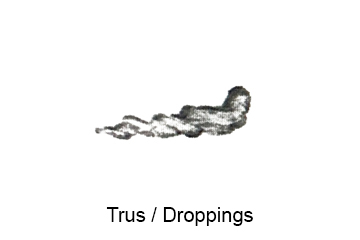Tchor tmavý je z čeľade lasicovité. Jeho domestikovaný poddruh sa volá fretka domáca.
Dĺžka života: 14 rokov (v zajatí)
Dĺžka gravidity: 40-43 dní, 3-8 mláďat
Hmotnosť: 1-1,5 kg
Živí sa hlodavcami.
Cez deň väčšinou spí. Úkryty opúšťa až za súmraku a v noci, keď sa vydáva za korisťou. Tchor využíva na svoju obranu prenikavo zapáchajúcu látku, ktorú vylučuje z pod chvostových žliaz. Smrad je to slušný.
Pri love v hospodárskych dvoroch odhryzne holubom, či králikom hlavy a obete uloží do kúta. Podľa toho ľahko zistíme, kto bol v noci na návšteve. Ešte pozoruhodnejší je spôsob, akým sa tchor zásobuje na zimné obdobie. Keď sa ho zima opýta, čo robil v lete, povie: ,,Chytal som žaby!“ Práve žaby sú pri tchorovi často súčasťou zimného jedálneho lístka. Pri love žabu nezabije. Zahryzne jej do chrbta, čím ju ochromí a takúto nepohyblivú obeť odvlečie do svojej zásobárne. Obojživelník sa síce nemôže pohybovať a ani prijímať potravu, no žije celé týždne. Keď teda v januári tchora pochytí hlad, kŕmi sa takto paralyzovanými žabami.
Výborne pláva. Ľudia tieto malé šelmy vďaka ich schopnostiam kedysi chovali a využívali na lov králikov.
Common polecat (Mustela putorius)
The black polecat (Mustela putorius) belongs to the weasel family. Its domesticated subspecies is known as the domestic ferret (Mustela putorius furo).
Lifespan: Up to 14 years (in captivity)
Gestation period: 40–43 days, with 3–8 cubs per litter
Weight: 1–1.5 kg
The black polecat primarily feeds on rodents. It is mostly nocturnal, sleeping during the day and emerging at dusk or night to hunt.
For defense, the polecat secretes a strong-smelling substance from glands under its tail, though the odor is relatively mild compared to skunks.
When hunting in farmyards, it is known to bite off the heads of pigeons or rabbits and stash its prey in a corner, making it easy to identify its nighttime visits.
One of its most remarkable survival strategies is how it prepares for winter. A common part of its winter diet includes frogs. However, rather than killing them immediately, the polecat bites into their backs, paralyzing them. It then drags the immobilized frogs to its food storage. Though the frogs cannot move or eat, they remain alive for several weeks. When food becomes scarce in January, the polecat consumes the still-living, paralyzed frogs.
The polecat is also an excellent swimmer. Historically, people bred these small predators for their hunting abilities, particularly for rabbit hunting.

 sk
sk
 hu
hu
 en
en

